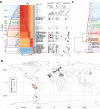Ancient Clostridium DNA and variants of tetanus neurotoxins associated with human archaeological remains
- PMID: 37673908
- PMCID: PMC10482840
- DOI: 10.1038/s41467-023-41174-0
Ancient Clostridium DNA and variants of tetanus neurotoxins associated with human archaeological remains
Abstract
The analysis of microbial genomes from human archaeological samples offers a historic snapshot of ancient pathogens and provides insights into the origins of modern infectious diseases. Here, we analyze metagenomic datasets from 38 human archaeological samples and identify bacterial genomic sequences related to modern-day Clostridium tetani, which produces the tetanus neurotoxin (TeNT) and causes the disease tetanus. These genomic assemblies had varying levels of completeness, and a subset of them displayed hallmarks of ancient DNA damage. Phylogenetic analyses revealed known C. tetani clades as well as potentially new Clostridium lineages closely related to C. tetani. The genomic assemblies encode 13 TeNT variants with unique substitution profiles, including a subgroup of TeNT variants found exclusively in ancient samples from South America. We experimentally tested a TeNT variant selected from an ancient Chilean mummy sample and found that it induced tetanus muscle paralysis in mice, with potency comparable to modern TeNT. Thus, our ancient DNA analysis identifies DNA from neurotoxigenic C. tetani in archaeological human samples, and a novel variant of TeNT that can cause disease in mammals.
© 2023. Springer Nature Limited.
Conflict of interest statement
The authors declare no competing interests.
Figures




Similar articles
-
Widespread occurrence of botulinum and tetanus neurotoxin genes in ancient DNA.Toxicon. 2025 Jul;262:108405. doi: 10.1016/j.toxicon.2025.108405. Epub 2025 May 13. Toxicon. 2025. PMID: 40368150
-
The population structure of Clostridium tetani deduced from its pan-genome.Sci Rep. 2019 Aug 2;9(1):11220. doi: 10.1038/s41598-019-47551-4. Sci Rep. 2019. PMID: 31375706 Free PMC article.
-
Tetanus Toxin Synthesis is Under the Control of A Complex Network of Regulatory Genes in Clostridium tetani.Toxins (Basel). 2020 May 15;12(5):328. doi: 10.3390/toxins12050328. Toxins (Basel). 2020. PMID: 32429286 Free PMC article.
-
Regulatory Networks Controlling Neurotoxin Synthesis in Clostridium botulinum and Clostridium tetani.Toxins (Basel). 2022 May 24;14(6):364. doi: 10.3390/toxins14060364. Toxins (Basel). 2022. PMID: 35737025 Free PMC article. Review.
-
Tetanus in animals.J Vet Diagn Invest. 2020 Mar;32(2):184-191. doi: 10.1177/1040638720906814. Epub 2020 Feb 18. J Vet Diagn Invest. 2020. PMID: 32070229 Free PMC article. Review.
Cited by
-
Database resources of the National Center for Biotechnology Information.Nucleic Acids Res. 2024 Jan 5;52(D1):D33-D43. doi: 10.1093/nar/gkad1044. Nucleic Acids Res. 2024. PMID: 37994677 Free PMC article.
-
AdDeam: a fast and scalable tool for estimating and clustering reference-level damage profiles.Bioinformatics. 2025 Aug 2;41(8):btaf407. doi: 10.1093/bioinformatics/btaf407. Bioinformatics. 2025. PMID: 40674584 Free PMC article.
-
AnnoView enables large-scale analysis, comparison, and visualization of microbial gene neighborhoods.Brief Bioinform. 2024 Mar 27;25(3):bbae229. doi: 10.1093/bib/bbae229. Brief Bioinform. 2024. PMID: 38747283 Free PMC article.
-
Tetanus: historical and palaeopathological aspects considering its current health impact.J Prev Med Hyg. 2025 Jan 31;65(4):E580-E585. doi: 10.15167/2421-4248/jpmh2024.65.4.3376. eCollection 2024 Dec. J Prev Med Hyg. 2025. PMID: 40026424 Free PMC article.
-
Comparative pathogenomic analysis reveals a highly tetanus toxin-producing clade of Clostridium tetani isolates in Japan.mSphere. 2023 Dec 20;8(6):e0036923. doi: 10.1128/msphere.00369-23. Epub 2023 Nov 27. mSphere. 2023. PMID: 38009947 Free PMC article.
References
-
- Megighian A, Pirazzini M, Fabris F, Rossetto R, Montecucco C. Tetanus and tetanus neurotoxin: From peripheral uptake to central nervous tissue targets. J. Neurochem. 2021;158:1244–1253. - PubMed
-
- Pappas G, Kiriaze IJ, Falagas ME. Insights into infectious disease in the era of Hippocrates. Int. J. Infect. Dis. 2008;12:347–350. - PubMed
-
- Miles SH. Hippocrates and informed consent. Lancet. 2009;374:1322–1323. - PubMed
-
- Sanchez, G. M. & Burridge, A. L. Decision making in head injury management in the Edwin Smith Papyrus. Neurosurg. Focus23, 1–9 (2007). - PubMed
Publication types
MeSH terms
Substances
Associated data
Grants and funding
LinkOut - more resources
Full Text Sources
Medical

